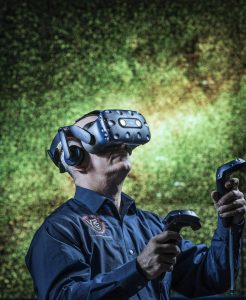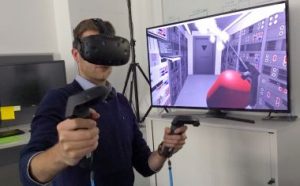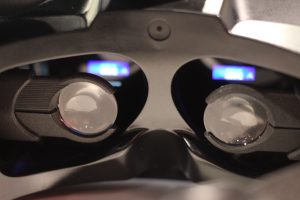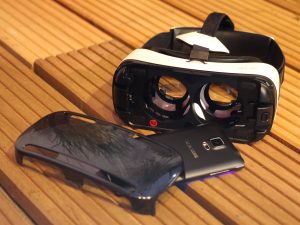Virtual reality (VR) is a simulated experience that can be similar to or completely different from the real world. Applications of virtual reality can include entertainment (i.e. video games) and educational purposes (i.e. medical or military training).

Image source: https://search.creativecommons.org/photos/13e8fa18-977e-4358-93b7-371fa7950e53 by NASA Goddard Photo and Video
Currently standard virtual reality systems use either virtual reality headsets or multi-projected environments to generate realistic images, sounds and other sensations that simulate a user’s physical presence in a virtual environment. A person using virtual reality equipment is able to look around the artificial world, move around in it, and interact with virtual features or items.
What’s virtual reality?
The definition of virtual reality comes, naturally, from the definitions for both ‘virtual’ and ‘reality’. The definition of ‘virtual’ is a representation that is close to reality and reality is what we experience as human beings. So the term ‘virtual reality’ basically means ‘near-reality’. This could, of course, mean anything but it usually refers to a specific type of reality emulation.

Image source: https://en.wikipedia.org/wiki/Virtual_reality
Everything that we know about our reality comes by way of our senses. In other words, our entire experience of reality is simply a combination of sensory information and our brains sense-making mechanisms for that information. It stands to reason then, that if you can present your senses with made-up information, your perception of reality would also change in response to it. You would be presented with a version of reality that isn’t really there, but from your perspective it would be perceived as real. Something we would refer to as a virtual reality.
How to enter the virtual world
This is more difficult than it sounds, since our senses and brains are evolved to provide us with a finely synchronised and mediated experience. If anything is even a little off we can usually tell. This is where you’ll hear terms such as immersiveness and realism enter the conversation. These issues that divide convincing or enjoyable virtual reality experiences from jarring or unpleasant ones are partly technical and partly conceptual. Virtual reality technology needs to take our physiology into account. For example, the human visual field does not look like a video frame. We have (more or less) 180 degrees of vision and although you are not always consciously aware of your peripheral vision, if it were gone you’d notice. Similarly when what your eyes and the vestibular system in your ears tell you are in conflict it can cause motion sickness. Which is what happens to some people on boats or when they read while in a car.

Image source: https://search.creativecommons.org/photos/2323c680-738c-4ea9-a0c5-68c369136e0a by pestoverde
Virtual reality equipment
Virtual Reality’s most immediately-recognizable component is the head-mounted display (HMD).The lenses of the headset are responsible for mapping the up-close display to a wide field of view, while also providing a more comfortable distant point of focus. A challenge of it is providing consistency of focus: because eyes are free to turn within the headset, it’s important to avoid having to refocus to prevent eye strain.

Image source: https://en.wikipedia.org/wiki/Virtual_reality#/media/File:Samsung_Gear_VR_(15060788240).jpg
Fresnel lenses are commonly used in virtual reality headsets due to their compactness and lightweight structure. The lenses do not use multiple pieces of material in their lenses like others do, instead the lens will be broken down into sections, allowing the individual to have a wider range of view. The issue seen with the lens consists of seeing the ridges of the lenses when the headset is not properly aligned on the head. The lenses introduce distortion and chromatic aberration, which are typically corrected in software.
Application of Virtual reality
There are many more uses of VR than first realised which range from academic research through to engineering, design, business, the arts and entertainment. But irrespective of the use, virtual reality produces a set of data which is then used to develop new models, training methods, communication and interaction. In many ways the possibilities are endless.

Image source: https://www.flickr.com/photos/usnavyresearch/23128666659 by Office of Naval Research
The only stumbling blocks are time, costs and technological limitations. Virtual reality systems such as a CAVE system are expensive and time consuming to develop. Plus there are issues of ergonomics, specifically the need to design systems which are ‘user friendly’ and not likely to cause problems such as motion sickness. But if these problems are solved then there is an exciting future for virtual reality.
Info sources:
https://en.wikipedia.org/wiki/Virtual_reality_headset
